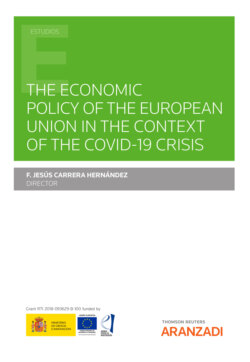Читать книгу The economic policy of the european union in the context of the covid-19 crisis - Francisco Jesús Carrera Hernández - Страница 7
На сайте Литреса книга снята с продажи.
2. THE TRIPLE SAFETY NET
ОглавлениеIt was decided to launch the triple safety net as a result of the agreement reached at the Eurogroup meeting held on April 9, 2020, and the videoconference held on April 23 by the European Council. Endowed with 540,000 million euros, it includes actions through the ESM through precautionary credit lines of up to 240,000 million euros (pandemic crisis support)18, the creation of a pan-European guarantee fund to help companies within the framework of the actions of the European Investment Bank (up to 200,000 million euros), and the creation of the SURE as a temporary solidarity instrument to grant loans to the Member States under favorable conditions. The set of measures adopted within the framework of the ESM and the EIB are subject to specific analysis in the aforementioned chapters, written respectively by Professor Ariadna Salazar Quiñónez and Professor Jorge Urbaneja Cillán.
Regardless of this, I would like to emphasize from this introductory chapter that the actions planned by the ESM are also a temporary instrument linked to the health crisis that presents certain peculiarities. On the one hand, the conditionality imposed on the States that request it has been reduced to a minimum. On the other hand, and although it is necessary to apply the surveillance foreseen in the ESM Treaty for these cases, a much more flexible approach has been decided. This implies not activating several of the provisions contained in Regulation 472/2013 for cases in which a Member State receives financial assistance of these characteristics (there will be no macroeconomic adjustment program, for example), applying the normal or standard system of surveillance in the framework of the European Semester19. This is because we have reached this situation with healthy economies, at least apparently: at the time the pandemic began, there was no procedure for excessive public deficit open, nor for excessive macroeconomic imbalances (although the latter have never been opened). On the contrary, there is a very high volume of public debt in states such as Italy or Spain, two of the states most affected by the pandemic within the EU, at least initially.
In any case, it should be remembered that we are dealing with a loan system (if the credit line is used) run by the Member States themselves through an intergovernmental cooperation mechanism created between the Eurogroup Member States. A program that, on the other hand, is clearly insufficient, as has become clear before its approval, not only for the amounts committed (Spain can request approximately half of what it received for financial assistance for bank recapitalization on the occasion of the 2008 financial crisis) but also because it does not reflect the genuine solidarity demanded by a good number of Member States in the face of a crisis that has a health and global nature20.
In relation to the SURE (temporary Support to mitigate Unemployment Risks in an Emergency) it has been adopted in the framework, and with legal basis, of art. 122.2 of the TFEU through Regulation 2020/67221. It is endowed with 100.000 million euros, available until December 2022 for the twenty-seven Member States. It has been created to combat the COVID-19 outbreak and respond to its socio-economic consequences. It is an instrument of financial assistance to the Member States suffering, or are at risk of suffering, a serious economic disturbance caused by the health crisis and makes it possible to finance, in addition to national measures, working time reduction schemes or similar measures designed to protect employees and the self-employed (e.g., temporary labor force adjustment plans and temporary cessation of activity) and, incidentally, certain measures related to health protection.
Financial assistance to the Member States takes the form of loans granted by the European Union to be repaid in various installments, without introducing other types of solidarity. The mechanism is financed through loans contracted on the capital markets or with financial institutions on behalf of the EU. In any case, as a condition of availability, the Member States must contribute with at least 25% of the total amount in the form of guarantees (each Member State according to its contribution to the total gross national income of the European Union)22. Nineteen Member States have received assistance from the SURE following the agreements reached within the Council23.
Therefore, the SURE is the third instrument created with these characteristics to provide assistance to EU Member States, after the Balance of Payments support mechanism and the European Financial Stabilisation Mechanism (EFSM)24. However, this is the first time that the EU has issued social bonds25. The first issues took place in October 2020 for an amount of 17,000 million euros, and, in the same month, the distributions of loans to the Member States began26.
